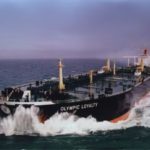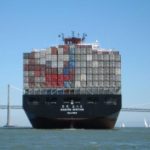Dry bulk market to remain under pressure for the rest of 2012

In an interview with Hellenic Shipping News Worldwide, Mr. Yannis Pachoulis, President of the Hellenic Shipbrokers’ Association, remains cautiously optimistic regarding the dry bulk market’s long-term prospects. He states that the current downturn was expected, as more and more newbuilding vessels were scheduled to hit the water, on the back of a huge orderbook. He adds that with global dry bulk trade expected to increase exponentially during the next few years, the current oversupply of dry bulk tonnage will be gradually absorbed, thus helping to bring freight rates back to more sustainable levels.
Since the start of the year, we’ve witnessed a dry bulk market collapse. Why has this occurred? Was the fall expected or did its extent take some under surprise?
Well we cannot name it a ‘collapse’. It is indeed a free fall, but bearing in mind the world’s economy situation together with the oversupply of tonnage due to mass deliveries of newbuildings, ordered during the last five years, brought the tough times of shipping industry we are experiencing now. The fall was expected as the supply of tonnage increased dramatically and broke the balance of supply and demand. I am sure that the prudent owners and brokers have predicted this fall and in most cases were prepared for it.
Is China in a position to be the dry bulk market’s powerhouse, like it has been in the past years?
For the last decade China proved to be the dry bulk market’s powerhouse. As the Chinese Government’s 20 years development plan is running , raw materials will be needed, so it will still remain the master powerhouse not only for shipping but for trading also. We have to keep in mind that although the imports of iron ore, which is the primary raw material, might decrease, the imported iron ore is going to be well above half a billion tons. China’s total output in iron ore is estimated to be around 1.5 billion tons this year against 1.33 billion tons in 2011 out of which 686 million tons were imported. It is therefore obvious that China will remain the great source of seaborne trade.
How do you see the market behaving in months until the end of the year? Is a rebound to healthier levels imminent or will ship owners have to be patient and weather the storm?
It’s a good question. Personally, I don’t see great changes till the end of the year – which in my opinion is healthy – of course we are expecting an increase in 4th quarter as it is common in shipping, but nothing extraordinary. The fluctuations of the market will continue and the usual geographical gaps will remain. Shipping as a globalized industry has to be patient, following the international trade market which is showing some optimistic signs, for example the growth of the world trade predicted to reach close to 100 % next 15 years with specific areas like S.America, India, Australia, China, Mexico, African and South East Asian countries expected to play a prime role in future. In the meantime India’s coal imports have already increased during the last three years and expected to have a further increase of approximately 35-36 % in the years to come.
What about demolition activity? Is scrapping activity enough to compensate for part of the newbuilding deliveries?
Demolition is definitely a way to assist the balance of supply and demand. We have already seen a great increase in scrapping activity the last three years. It is obvious that a weak market is leading most of the overaged tonnage to the scrapyards. During 2010 the total dwt scrapped was 28 million tons, 2011 was 42 million tons and the number is growing by nearly 50% during 2012. Scrap prices are still high and owners should take advantage of the prevailing needs and prices and lead their old tonnage to demolition yards, thus giving a chance to their younger tonnage to survive. The average age of scrapped tonnage jumped from 30.5 years in 2010 to 28 years today for dry cargo vessels and 22 years for tankers.
In terms of demand, could other countries like India come to the help of dry bulk ship owners?
As explained hereabove, India’s coal imports are likely to increase from 137 to 185 million tons. Having a target growth rate of 7.5 per cent per year, India seems to be one of the leading countries worldwide in terms of industrial and agricultural infrastructure. And it’s not the only one. There are other economies which are giving signs of emerging growth. Russian economy with the known resources, Brazil with the sugar and iron ore trade, Argentina with the grain production, USA and Canada with their industrial and grains products, Australia with the iron ore and coal exports. It’s a promising lot, therefore we should be optimistic for the future of shipping.
Do you expect shipping companies to come under further pressure from banks and lenders in general, with some of them even exiting the market all together?
It all depends on the policy of the banks. There is indeed a pressure, especially to shipowners which purchased their fleet during the very high market of 2006-2008, when the values were sky high. We have recently seen banking and financing organizations to resign from their shipping activities for various reasons, like Commerzbank – being a key player in shipping finance-which decided to exit shipping . But in the meantime we have also experienced refinancing facilities from banks which were not heavily involved in the industry. Hopefully we are not going to see unfortunate events i.e. shipping companies exiting the shipping market due to financial problems created by banks.
Do you believe that the latest fuel regulations regarding ship emissions will ultimately lead to “greener” vessels? Are ship owners looking to build more efficient vessels, or will their preferred solution be to install new engine technologies onboard existing vessels in order to comply with low-sulphur fuel regulations?
Definitely the new fuel regulations are already leading shipowners in building ‘greener’ vessels. Most of the major shipyards have already created new designs of eco-type vessels which will be the leading force in future. Apparently the shipyards following the high bunker prices and the new regulations are trying to create environment friendly vessels with low consumption using, at least in the areas where imposed, the low-sulphur bunkers.
On the other hand the already existing fleet will have to harmonize with the new regulations so the owners have to make all necessary arrangements in order to comply with them, otherwise they are going to face ‘prohibited areas’ in the trade of their ships.
How has the eurozone debt crisis and more importantly the Hellenic financial woes affected your day-to-day business?
We are living in Greece and as Greeks, we are facing the problem of this crisis. It is definitely affecting our life but in the meantime strengthens our will to assist in any possible way our country to overcome this difficulty. Eurozone’s economical situation cannot be considered as smooth. There are different economical levels of the member countries and we have to reach an accepted balance. This is not easy but I strongly believe it can be achieved, provided that there will be understanding from all parties concerned. Our day-to-day business is running normally for the time being but definitely affected, having to live in an uncertain economical environment, but again we are optimistic.
Nikos Roussanoglou, Hellenic Shipping News Worldwide

 Hellenic Shipping News Worldwide Hellenic Shipping News Worldwide, Online Daily Newspaper on Hellenic and International Shipping
Hellenic Shipping News Worldwide Hellenic Shipping News Worldwide, Online Daily Newspaper on Hellenic and International Shipping























 PG-Software
PG-Software